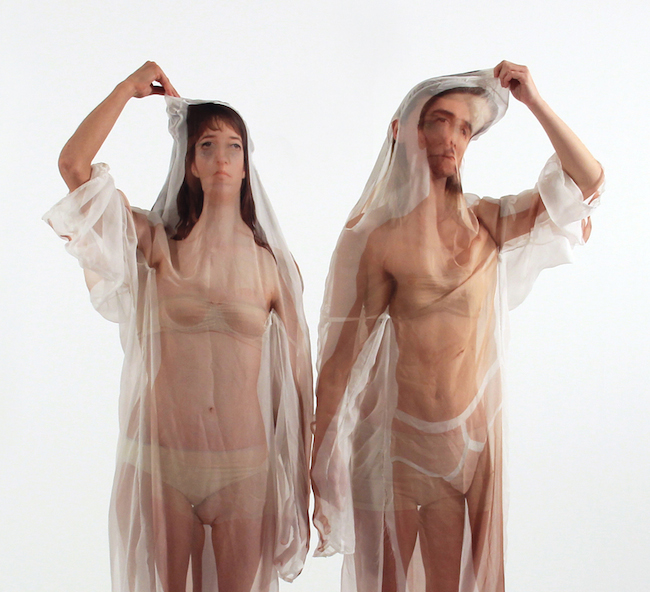How do contemporary ceramics (indeed, any objects) respond to a world in which people are spending more and more time in virtual space? The Van Abbemuseum, in cooperation with Design Academy Eindhoven tried to find the seam between form and void with “Thing Nothing,” (Eindhoven, October 17, 2015 — November 15, 2015). The exhibition brought together a wealth of designers who presented works that discussed the meaning, value and future of things.
The exhibition addressed the relation between form and counter-form, between the real and virtual, and between technological possibilities and ethical issues. The exhibition also asks how objects, tangible things, give scripts for intangible features of the physical world. Organizers with the Academy illustrate that point by telling students to “look beyond the material properties of things, and to search for a presence that Taoists might describe as ‘nothingness:’ the space in and around the object.”
Drawing those considerations out, some designers submitted objects that combine intangible virtual space with “real” space. Dezeen reports that !Mediengruppe Bitnik programmed a bot that would scour the deep web for random items to buy. On the ceramic side of things, Olivier van Herpt submitted his 3D printed vases, objects that exist within a computer until they’re made incarnate on his machine.

Imme van der Haak, Beyond the Body, 2012. Photograph courtesy of the museum. Click to see a larger image.
Imme van der Haak was born in Arnhem, the Netherlands. She studied product design at the Royal College of Art in London and graduated in 2012. Today she works in Hong Kong, making “playful, yet subtle” work that challenges perceptions of what is normal and everyday. With Beyond the Body, Imme altered the human form by adding “one simple intervention.” Images were printed on translucent silk, which allowed her to layer a real body with another of a different age, shape or identity.

Ted Noten, Mercedes-Benz E-Classe 210, Brooches, 2001. Installation view at Thing Nothing, 2015. Photograph by Peter Cox.
Amsterdam designer Ted Noten states that his works “act as a critique on contemporary life and the history of jewelry, as well as on the wider context of product design.” He confronts the familiarity of people’s everyday surroundings, often lifting symbols and placing them in a new context. He looks for the fixed meaning in the familiar and then debunks that meaning before bringing the object back into reality. “In affecting and infecting symbolic values,” the designer’s bio states, “he actually reveals their unmistakable intangibility.”

Olivier van Herpt & Sander Wassink, Adaptive Manufacturing, 2014. Installation view Thing Nothing, 2015. Photograph by Peter Cox. Click to see a larger image.
We wrote about Olivier van Herpt one year ago. The Eindhoven designer plays with ceramics manufacturing by using 3D printing to create competent, useful ceramic objects. His process and the challenges facing it are worth reading about, if you haven’t yet. Wassink, van Herpt’s collaborator in this show, is an artist and designer from Eindhoven. He says that his work “encourages us to reconsider our ideas of beauty and aesthetic value.” His approach includes notions of history, memory and the preservation of a past that is slipping away.

Jetske Visser, Forgotten Memory. Photograph by Visser and Joost Goovers, courtesy of the museum. Click to see a larger image.
Eindhoven designer Jetske Visser says she uses her work to reveal things that lie beneath the surface, turning rarely discussed subjects into something tangible. That was at work with Forgotten Memory, a film about dementia. The movie attempts to expose the hidden world of dementia, asking difficult questions about tangible and familiar objects. For example: What is a teapot if you don’t know what a teapot is?”

The Why Factory and MVDRV, The Porous City, 2012. Installation view Thing Nothing, 2015. Photograph by Peter Cox. Click to see a larger image.
The Why Factory is a think-tank and research institute run by MVRDV and Delft University of Technology. Porous City addresses the evolution of the skyscraper in Asia. Nine scale towers constructed from more than 1.5 million LEGO bricks are part of Why’s “ongoing research on the design of skyscrapers and the potential porosity as a European approach to urban density.”

“Thing Nothing” installation view, 2015. Background images are from “Digital Virtuosity” by Bastiaan de Nennie, 2015. Photograph by Peter Cox. Click to see a larger image.
With Digital Virtuosity, Bastiaan de Nennie took 3D scans of common, everyday objects and reassembled them into digital creations that can exist only in a virtual space. Seat belts, umbrellas, buttons and steering wheels were all warped in this way. The Eindhoven academy graduate told Dezeen that he considered the project a reverse design process, deconstructive. The mutations are callbacks to things that have outlived their usefulness to us. The designer is fascinated by objects from a pre-digital age that are rarely used today and while his creations only exist in a computer, they give him inspiration for other works.
What do you think of the concepts behind “Thing Nothing?” Let us know in the comments.


Add your valued opinion to this post.